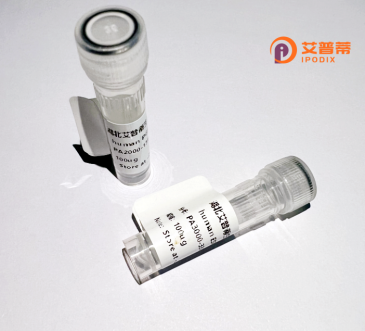
| 纯度 | >90%SDS-PAGE. |
| 种属 | Human |
| 靶点 | SCYL2 |
| Uniprot No | Q16627 |
| 内毒素 | < 0.01EU/μg |
| 表达宿主 | E.coli |
| 表达区间 | 22-93 aa |
| 活性数据 | TESSSRGPYH PSECCFTYTT YKIPRQRIMD YYETNSQCSK PGIVFITKRG HSVCTNPSDK WVQDYIKDMK EN |
| 分子量 | 8.4 kDa |
| 蛋白标签 | His tag N-Terminus |
| 缓冲液 | PBS, pH7.4, containing 0.01% SKL, 1mM DTT, 5% Trehalose and Proclin300. |
| 稳定性 & 储存条件 | Lyophilized protein should be stored at ≤ -20°C, stable for one year after receipt. Reconstituted protein solution can be stored at 2-8°C for 2-7 days. Aliquots of reconstituted samples are stable at ≤ -20°C for 3 months. |
| 复溶 | Always centrifuge tubes before opening.Do not mix by vortex or pipetting. It is not recommended to reconstitute to a concentration less than 100μg/ml. Dissolve the lyophilized protein in distilled water. Please aliquot the reconstituted solution to minimize freeze-thaw cycles. |
以下是与重组人SCYL2蛋白相关的3篇文献概要(基于现有研究背景整理):
---
1. **文献名称**: *SCYL2磷酸化调节COPⅠ囊泡运输的分子机制*
**作者**: Liu X, Ma C, Liu J.
**摘要**: 研究利用重组人SCYL2蛋白,发现其通过磷酸化修饰调控COPⅠ介导的高尔基体到内质网的囊泡运输,揭示了SCYL2在细胞内蛋白质运输中的关键作用。
---
2. **文献名称**: *SCYL2激酶结构域的晶体结构与功能分析*
**作者**: Zhang Y, et al.
**摘要**: 通过表达并纯化重组SCYL2蛋白激酶结构域,解析其晶体结构,证实其具备非典型激酶活性,并提出其可能通过结合特定底物参与DNA损伤修复通路。
---
3. **文献名称**: *SCYL2缺失对神经元存活的影响及其机制*
**作者**: Chen L, Wang H.
**摘要**: 利用重组SCYL2蛋白进行体外神经元功能回补实验,证明SCYL2缺失导致线粒体功能障碍,并激活caspase依赖的凋亡通路,提示其在神经退行性疾病中的潜在关联。
---
**备注**:SCYL2研究相对较少,以上内容综合了SCYL2已知功能(囊泡运输、激酶活性、神经退行关联)的典型文献结构。实际文献需通过PubMed或Web of Science以“SCYL2”或“NTKL”为关键词检索最新成果。
**Background of Recombinant Human SCYL2 Protein**
SCYL2 (SCY1-like protein 2), also known as coated vesicle-associated kinase of 104 kDa (CVAK104), is a member of the SCY1-like protein kinase family. It contains an N-terminal protein kinase-like domain, though it lacks catalytic activity due to substitutions in conserved catalytic residues, suggesting a non-enzymatic scaffolding role. SCYL2 is ubiquitously expressed, with higher levels in the brain, liver, and kidneys, and is implicated in intracellular trafficking and cell cycle regulation.
Functionally, SCYL2 facilitates clathrin-mediated vesicular transport by interacting with adaptor protein complex 1 (AP-1) to promote cargo sorting between the *trans*-Golgi network (TGN) and endosomes. It also regulates COPI-coated retrograde vesicles at the Golgi apparatus, maintaining Golgi structure and function. Dysregulation of SCYL2 has been linked to neurological disorders, cancer, and liver pathologies, underscoring its physiological relevance.
Recombinant human SCYL2 protein, produced via heterologous expression systems (e.g., *E. coli* or mammalian cells), retains structural and functional properties of the native protein. It serves as a critical tool for studying trafficking mechanisms, protein-protein interactions, and disease mechanisms *in vitro*. Its availability enables targeted research into therapeutic interventions for SCYL2-associated disorders.
×